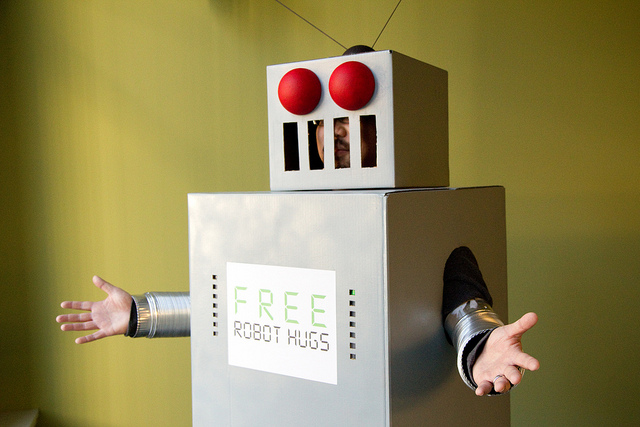Breakthrough in soft robotics
Interview with
A recipe for a soft robotic skin that's sensitive to touch and has the ability to change colour, like an octopus, has been developed by engineers in the US. This could pave the way for blushing robots and 3D phone displays. Rob Shepherd, who led the group behind the invention, told the group how it came about...
colour, like an octopus, has been developed by engineers in the US. This could pave the way for blushing robots and 3D phone displays. Rob Shepherd, who led the group behind the invention, told the group how it came about...
Rob - There's a field now called soft robotics and these machines are capable of working around humans safely, which is very important. But there are some things they can't do since their bodies are required to stretch to large degrees - we need electronics that can stretch with them. Some of the same students that were in my lab were taking a course on engineering with soft materials where I tasked them with coming up with a new device and they, on their own, decided it would be great to impart light emitting particles into these sensors. So now, they created a device that can sense touch and also emit light in red, green or blue.
Chris - Wow. So how does this work - talk us through effectively what you have made and how it actually does that?
Rob - So this material is rubber. There are two different kinds of rubber; there's one that doesn't conduct electricity and another one that does conduct current. And so, by layering sheets of these, we can create the sensors and the light emitting displays, and because it's all rubber, it stretches like rubber and it's soft like rubber.
Chris - So how do you make the rubber conduct electricity?
Rob - So this technique, actually, was developed a couple of years ago at Harvard. What they did is they put salt water inside of a rubber and we took that material and layered it with an insulating material and that composite is what gives us this new ability.
Chris - How does that architecture then - layers of a conducting rubber and a non-conducting - an insulating rubber - turn into something which a) can detect pressure and b) also make light?
Rob - Well what you've just described, we call a capacitor, and when we can stretch the capacitor, we change the distance between the plates of the capacitor. That capacitor's change results in a signal that we detect.
Chris - How do you get the light out though?
Rob - Well, in the insulating rubber we put light emitting particles and when we apply voltage across the plates, they emit light. One of the really cool features about the work is that it's made by casting a liquid and turning it into a rubber. Depending on how we cast it, we can have as many pixels as we like.
Chris - Then the application of this would be that if I built a robert with a human hand like structure, it would know when it was curving that surface around my hand to shake my hand. It would know how much it was stretching and, therefore, how much force it was applying to my hand so you wouldn't be in that ignominious situation where you've made a beautiful human-like robot that's capable of taking my arm off?
Rob - That's right. Since one of the major benefits of soft robots is that they can interact with humans safely. It's important to also let them feel what they are interacting with and that's what this does.
Chris - How easy is that to achieve thought? You've done this in a small piece of material, but could you extrapolate this to a whole robot?
Rob - That's exactly what we're doing right now. So our next step is to put this skin onto a larger, more functional robot and test it out and we believe it's very possible.
Chris - And now that you can get this beautiful lighting effect for free. I mean lots of people wear makeup; your robot could almost have light generated, self-made makeup, couldn't it, so it could even blush. What's the application of being able to put the light in there as well? Why is that helpful?
Rob - Well there's a few reasons. We make a point in the paper; there's two things this technology enables. One are robots that can change their colour and another are displays that change their shape and you pointed actually to a very important point - make-up is not useless. The ability to create an emotional response with the people you are interacting with is important and we believe, as robots work with people more, their ability to communicate information visually is very important and that's what we can do with this technology.










Comments
Add a comment